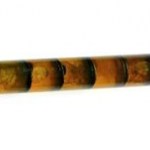carbon monoxide
Here are the highlights from the final day of the meeting:
Carbon monoxide (CO) is not all that bad: Michael Tift, graduate student at Scripps Institute of Oceanography, described how the body naturally produces CO when red blood cells are broken down and CO can actually be protective against inflammation at low doses. His research was focused on measuring whether species that have more hemoglobin (from living in hypoxic environments) also have more CO. As it turns out, people native to high-altitude Peru do have higher CO levels than those living at lower elevations. Likewise,…
Image of zebrafish By Pogrebnoj-Alexandroff from Wikimedia Commons
We tend to think of carbon monoxide (CO) only in terms of being a poisonous gas. The reason for its toxicity is due to its ability to bind really tightly to our hemoglobin molecules, which prevents oxygen from being able to bind. In mammals, CO also decrease breathing rate. As you can imagine, it is a pretty terrible gas to breath in when you are a species dependent on hemoglobin for delivery of oxygen to tissues.
Did you know that CO is also produced in our bodies when heme molecules are broken down by…
December's calendar photograph is a battery of five solar cells that also stores electricity in series. The cells were invented and developed at the Weizmann Institute in the late 1970s. These not only converted sunlight into electricity, but also could store some of that energy using a battery-type setup with electrodes in a chemical solution, so that they could provide electricity day and night.
The idea of efficiently storing solar energy has taken more than one twist and turn since then - various forms of artificial photosynthesis, for example. Interestingly enough, one of the latest…
Recently, at events for my book, I sometimes find myself describing the gas carbon monoxide as a favorite poison. "It's just so efficient," I'll joke. "And I like things that work."
In an academic sense, I do respectfully admire carbon monoxide's simplicity (a carbon atom + an oxygen atom) and the way such basic chemical addition creates something so deadly. But in light of last week's mining disaster in West Virginia (the subject of two previous posts on this blog), I want to acknowledge that poisonous efficiency is mostly a formula for tragedy.
If you followed the news reports on the fiery…
The old mining term for explosive gases in coal mines is "firedamp". It seems illogical - I mean, a damp fire? - until you realize that it comes from the German word "dampf" for vapors.
There are other "damps" in mining terminology - "afterdamp", for instance, refers to the poisonous gas carbon monoxide, which tends to build up in mines after an explosion. But firedamp explicitly refers to a gas mixture rich in the flammable gas methane, which - as the recent disaster in West Virginia's Upper Branch Mine reminds us - burns like a devil's torch. Twenty-five miners were killed outright in the…
Let me begin with a confession: until I researched and wrote a book about poisons, The Poisoner's Handbook, I never paid too much attention to National Poison Prevention Week.
Like most of us, I was just too comfortable with our chemical culture, the toxic compounds that we use daily to clean our sinks and counters, polish our furniture and our fingernails, keep our cars running. We depend on these compounds and we live with them daily, never fully considering that we've turned ourselves into guinea pigs, test cases for chemical exposure.
They worried about this more acutely in the 1920s and…
Last week, The Poisoner's Handbook got a great, pre-publication review in one of my favorite magazines, New Scientist. I was thrilled - and relieved. Hard to say which came first. The week before publication - the book's official date is Feb. 22 - always makes me a little crazy.
But much as I like my work being called "fascinating" (and I do, I do), it was the closing sentence of the review that really spoke to me: "Alas, sometimes the poisoners we seek are ourselves." Collins was referring to the findings by the 1920s toxicologist in my book that carbon monoxide was…
Just before this weekend's stunning snow storm arrived in the Mid-Atlantic, poison control centers started issuing chirps of alarm.
I thought of them as chirps - something like the peeping alarm calls of small birds - because they sounded so faint against the other looming worries - adequate food supplies, airport closures, shut downs in government services.
And yet the fact is that more people have already been poisoned as a result of the monster storm than have suffered from starvation. The Washington Post today reported eight people treated for carbon…
In 1854, the essayist Henry David Thoreau published an ode to a morning fire: "Light-winged Smoke, Icarian bird... Lark without song, and messenger of dawn." Scientists, of course, saw the hazing blue of wood smoke - or any smoke derived from burning plant material - as something less poetic. In particular, the smoke from dried leaves of the tobacco plant attracted serious attention from chemists by the end of the 19th century.
Victorian scientists had, for instance, calculated that cigarette smoke was about four percent carbon monoxide, a poisonous gas which directly interferes with…
